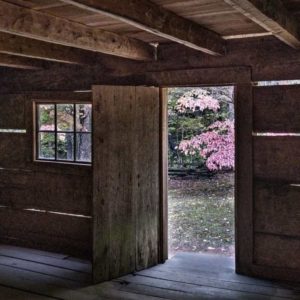 Hosted by Bob and Willa Friedman
Hosted by Bob and Willa Friedman
 The following are some ideas you may want to consider regarding our upcoming field trip to the Great Smoky Mountains National Park.
The following are some ideas you may want to consider regarding our upcoming field trip to the Great Smoky Mountains National Park.
This is a very large park with more than 500,000 acres with much to see and do.. It is one of the most ecologically varied areas in the world. You could easily spend a month here, but to spend your limited time in the park wisely, we strongly suggest some advanced planning – check out GSMNP web site, www.nps.gov/grsm , and enter “Great Smoky Mountains” into Google. Also, purchase Photo Traveler’s, “Guide to the Great Smoky Mountains & Shenandoah National Parks.” It costs $15.95 and is available by calling 800-417-4680 or going to www.phototraveler.com . This guide is written for photographers by photographers and outlines the photographic opportunities in the park. It tells you what there is to see, how to get there, and at what time of day to be there for the best photo opportunities. This is an extremely valuable resource for maximizing your time in the park and I strongly urge you to purchase one. Don’t leave home without it.
Your first order of business when you arrive on Wednesday is to obtain a park map from one of the park’s visitor centers. Townsend Visitor Center is the closest (open 9:00-5:00). It is located in Townsend, along US 321. There is also one located in Cades Cove (open 9:00-7:00).
Townsend Visitor Center is the closest (open 9:00-5:00). It is located in Townsend, along US 321. There is also one located in Cades Cove (open 9:00-7:00).
We will be gathering at 6:30 pm on Wednesday in the Econoladge Parkside lobby to go to dinner where we will discuss Thursday’s activities. Outlined below are some park highlights you may want to see. These are only suggestions and may be modified according to the weather and your own tastes and interests.
Day 1:
You can easily spend most of the day driving around Cades Cove stopping every quarter mile or so to photograph horses, deer, settlers’ cabins, churches, scenery, etc. Be sure to stop at the Cades Cove Visitor Center where there is a working gristmill. You may want to pack a lunch because this is a loop road.
You should be at the gate into Cades Cove when it opens at sunrise. At this time of year morning fog is usually in the valley making the ordinary extraordinary – don’t miss it. If you finish photographing Cades Cove in the afternoon, I suggest you return towards Townsend might want to continue back past the park entrance and take the Tremont road—there are wild flowers and a running stream.
For your sunset photos, plan to go to Clingmans Dome one evening depending upon the weather.
Day 2:
Start your day by photographing the river along Little River Road. There are many places where you can park your car and walk down to the river. This road ends at the Sugarlands Visitor Center. There is a short movie at the visitor center showing the history of the park. It’s well worth the time to see it. Behind the visitor center, there is a flat 1-mile nature hike to a cabin and also a short hike to the 40-foot high Cataract Falls.
Either pack lunch or turn onto Route 441 and head into Gatlinburg for lunch. At traffic light number 8 turn right to go to the Roaring Fork area of the park. It is best to visit this area in the afternoon. The road makes a big loop with places to stop and photograph, similar to Cades Cove, except it’s on the side of a mountain. There are many homesteads to investigate and photograph along with the Roaring Fork Stream. Down the path from the first homestead there are rare pink lady slippers that are worth photographing, however they are nestled in poison ivy. There are opportunities for hikes to several waterfalls along the way. Two of these are of interest. First, Rainbow Falls is a 3.9 mile roundtrip hike to the falls. A rainbow can be photographed at the falls on a sunny afternoon. Second, Grotto Falls is a fairly easy 3-mile round trip hike to the 20-foot falls. There should be wildflowers along the trail. On Monday, Wednesday, and Friday you may encounter pack llamas bringing supplies to LeConte Lodge. Finally, toward the end of the loop you will come to the “Place of a Thousand Drips.” It is on the left side of the road and is well worth stopping and photographing. The parking lot can hold only about 2 cars so you may have to wait for someone to leave. It also may be worth carpooling.
After finishing the loop you may want to get dinner while in Gatlinburg. For sunset photos you should consider going to Clingmans Dome. Clingmans Dome is the highest point in the park and it is cold up there, so bring a heavy winter coat. I got “frozen out” last year and was happy to watch the sunset from the front seat of my car. You can photograph the sunset from the parking lot or take the steep ½-mile hike to the observation tower for a 360-degree view.
Day 3
If you can spend three days, I suggest the following: From Townsend, follow the Little River Road again to Route 441, Newfound Gap Road. This time turn right and head into the park and up the mountain. The first stop is Chimney Tops Picnic Area where you can photograph wildflowers. My Photo Traveler’s Guide claims the area is covered with wildflowers in mid April and you don’t have to carry your tripod very far since the parking lot and edge of the road are covered with flowers Also, there are many wildflowers along the ¾-mile long Cove Hardwood Nature Trail.
Continue following the Newfound Gap road to Mingus Mill which is ½-mile before the Oconaluftee Visitor Center. This gristmill is well worth photographing. At the Oconaluftee Visitor Center is the Mountain Farm Museum. There are a bunch of 19th century farm buildings and fences that are interesting to photograph.
If time permits, you might try photographing Tom’s Branch Falls. For directions to the falls check the park map.
Plan your return trip so you will be at Clingmans Dome at sunset. Be sure to bring warm clothing.
If you need to go home on Sunday, Bob and I suggest you go to Foot Hills Parkway for sunrise. The first overlook on the left should have a good view. Then return to Townsend for brunch and leave for home. This will also enable you to by-pass Gatlinburg and Pigeon Forge traffic.
The following are other destinations worth considering:
Greenbrier turnoff is located 6 miles east of Gatlinburg on Route 321. This is a great place for spring wildflowers especially along the easy Porters Creek Trail. You can photograph the river along the road and hike up to Fern Branch Falls on the Porters Creek Trail. This trail may be one of the best wildflower locations in the park. It is a very easy 1.9-mile hike to the falls. For details see pages 23 and 24 of your Photo Traveler’s Guide.
Albright Grove of old-growth timber is located in the Cosby area of the park. For details in finding the Albright Grove check out page 25 in the Photo Traveler’s Guide. It is a moderate 7-mile roundtrip hike with 1600 feet of elevation gain along the Maddron Bald Trail. There is an old pioneer cabin in the first ½ mile of the hike. Of course, there are wildflowers, and small waterfalls where the trail crosses Indian Creek. Once you get to the grove you will see how the Smokes looked before they were logged.
If you love streams, cascades and waterfalls then plan on spending a day photographing along Big Creek on the eastern end of the park – see page 27 in your Photo Traveler’s Guide. It is an easy hike up the Big Creek Trail to Midnight Hole and Mouse Creek Falls. Photographers generally hike up Big Creek Trail photographing the pools, streams, cascades and waterfalls for half a day and then turn around and “shoot” their way back to the car.
A final note: When you plan your day, be sure to also plan your meals. There are no restaurants in the park that I’m aware of. I believe you may be able to buy food at some of the campgrounds in the park. You may want to carry an emergency stash of food in your car.
Modified by Bob and Willa Friedman, 2008
Things to bring:
Tripod—to take long exposures of the streams.
Waterproof pants, extra shoes, cover for camera, rainwear, ground cloth—this area gets about 85 inches of rain per year. Some of it may fall during our visit.
Polarizing filter—to take the shine off wet foliage.
ND filters, reflector, diffusers, etc. You will be photographing in full light and heavy shade—macro and landscapes and everything in between.
Knee pads for macro shots of flowers.
Winter jacket for sunrise and sunset.
Snacks and water.
Lunch! Bob and I carry peanut butter and bread because we are having too much fun to drive miles looking for lunch.
